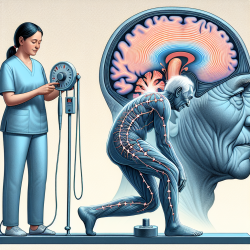Introduction
Progressive Supranuclear Palsy (PSP) is a neurodegenerative disorder characterized by severe postural instability and frequent falls. Traditional treatments have limited efficacy, particularly in addressing balance issues. Recent research, such as the study by Dale et al. (2023), highlights the potential of cerebellar repetitive transcranial magnetic stimulation (rTMS) as a novel intervention to improve postural stability in PSP patients.
Understanding the Study
The study conducted by Dale and colleagues explores the efficacy of cerebellar rTMS in improving balance in PSP patients. Utilizing a randomized, single-blind, crossover design, the research involved 30 participants undergoing both active and sham rTMS sessions. The primary outcomes measured included changes in sway area and medio-lateral range of sway, providing objective metrics of postural stability.
The research also incorporated secondary outcomes such as gait analysis and clinical balance scales, offering a comprehensive view of the intervention's impact. Notably, the study utilized functional near-infrared spectroscopy (fNIRS) to explore cortical activity changes, providing insights into the neural mechanisms underlying balance improvements.
Key Findings
- Improved Postural Stability: The study found significant reductions in postural sway following active rTMS sessions compared to sham sessions, indicating enhanced balance control.
- Neural Mechanisms: fNIRS data suggested decreased oxygenated hemoglobin concentration in the primary motor cortex during complex motor tasks post-rTMS, reflecting improved cerebellar-brain inhibition.
- Safety and Tolerability: The intervention was well-tolerated, with no significant adverse effects reported, underscoring its potential as a safe therapeutic option.
Implications for Practitioners
For speech-language pathologists and other practitioners working with PSP patients, these findings offer promising avenues for enhancing therapeutic outcomes. Incorporating cerebellar rTMS into treatment plans could complement existing therapies, providing a multi-faceted approach to managing postural instability.
Practitioners are encouraged to stay informed about ongoing research in this area and consider participating in or initiating studies to further explore rTMS's potential. Collaboration with neurologists and other specialists can facilitate a comprehensive care approach, optimizing patient outcomes.
Encouraging Further Research
While the results are promising, further research is needed to refine rTMS protocols and understand the long-term effects of cerebellar stimulation in PSP. Practitioners can play a pivotal role in advancing this field by contributing to research efforts and advocating for increased funding and resources.
To read the original research paper, please follow this link: C-STIM: Protocol for a randomized, single-blind, crossover study of cerebellar repetitive transcranial magnetic stimulation (rTMS) for postural instability in people with progressive supranuclear palsy (PSP).










